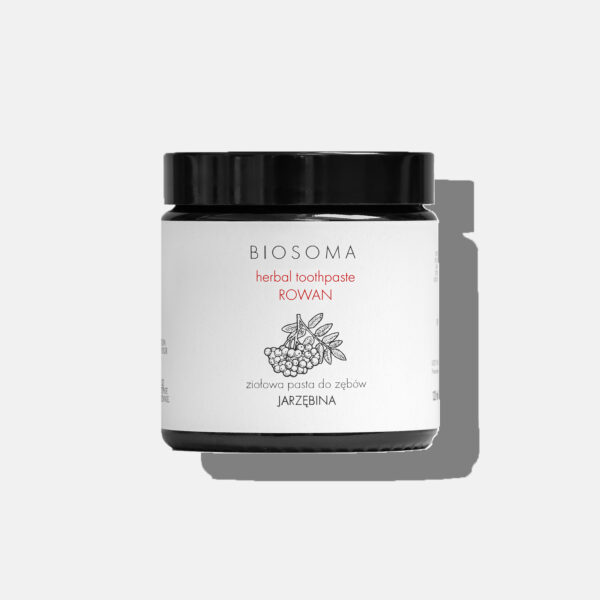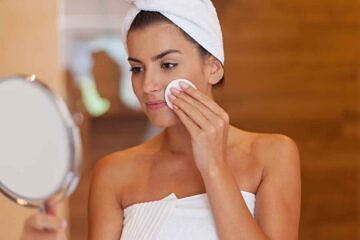Zęby to niewątpliwie wizytówka każdego człowieka. Zadbane i zdrowe są piękną ozdobą naszego uśmiechu. Tutaj chciałabym Wam opowiedzieć, jak dbać o nie bez toksycznych składników i co robić, żeby posłużyły nam długi czas. Zaznaczam, że nie jestem lekarzem, także moje informacje to nie porada lekarska 🙂
Niestety dorastałam w czasach, kiedy stomatologia i ortodoncja wyrządzały więcej szkód niż pożytku. Również świadomość wielu rzeczy była zupełnie inna niż teraz. Dlatego tutaj robię „ściągę” z tego wszystkiego, co wg mnie jest naprawdę ważne.
1. Ssanie oleju kokosowego
Pierwszą i chyba najważniejszą rzeczą to ssanie oleju kokosowego (=płukanie ust olejem). Olej kokosowy ma silne właściwości antybakteryjne. Czy wiesz, że w jamie ustnej człowieka żyć może około 700 rodzajów bakterii, z czego w dowolnym czasie, w Twoich ustach można znaleźć aż połowę z nich?
Niektóre z tych bakterii przyczyniać się mogą niestety do takich problemów jak próchnica, nieświeży oddech czy choroby dziąseł. Ssanie oleju kokosowego może być zatem bezpieczną i efektywną alternatywą dla płynów do płukania ust z chlorheksydyną, która może podrażniać błony śluzowe. Płucząc usta, olej kokosowy zlepia się ze szkodliwymi bakteriami i usuwa je z zębów.
Gdy płuczesz zęby olejem to pozbywasz się toksyn z organizmu, wzmacniasz dziąsła (zwłaszcza kiedy krwawią) a nawet wzmacniasz kości, w których masz osadzone zęby. Co więcej, olej świetnie rozpuszcza kamień i wszelkie osady na szkliwie. Lista korzyści jest naprawdę długa!
Jak płukać zęby olejem kokosowym?
Płukanie olejem wykonuje się rano, przed jedzeniem, używając jednej łyżeczki oleju. Przez 5-20 minut starannie płuczemy usta olejem, szczególną uwagę zwracając na boczne ścianki jamy ustnej. Następnie olej wypluwamy do kosza (umywalkę może zatkać), aby pozbyć się toksyn i płuczemy samą wodą.
Możesz użyć inny olej, np. sezamowy, słonecznikowy. Też będzie dobry.
2. Czyszczenie powierzchni między zębami
Samo ssanie oleju nie zastąpi szczotkowania i nitkowania zębów. To nie jest alternatywa, a jedynie wstęp do posiadania zdrowej jamy ustnej, zwłaszcza dziąseł i kości.
Zanim przejdziesz do szczotkowania, należy oczyścić przestrzenie między zębami z resztek utkniętego jedzenia. Ważne jest to dlatego, że takie jedzenie jest pożywką dla tych niechcianych bakterii, a pominięcie tego etapu zniweczy cały nasz trud. W internecie możesz znaleźć naturalne nici do zębów, szczoteczki międzyzębowe lub irygator.
3. Czyszczenie zębów oraz języka
Ten etap pielęgnacji pewnie znasz od pierwszego swojego zęba. Tylko teraz zwróć uwagę na skład swojej pasty do zębów. Nie wszystkie bowiem pasty, nawet te które posiadają pozytywną opinię Polskiego Towarzystwa Stomatologicznego, są dobre. Jeśli chcesz naturalnie i dobrze dbać o higienę jamy ustnej to zwróć uwagę na:
3.1. Pasta nie musi się pienić.
Pasta do zębów nie musi się pienić. Piana spowodowana jest przez dodatek surfaktantów, czyli środków myjących. Czy jest to potrzebny składnik do prawidłowej higieny jamy ustnej? Wg mnie nie. Surfaktant nie wnosi nic poza pianą do pasty.
3.2. Unikaj dwutlenku tytanu
Dwutlenek tytanu był dopuszczony do stosowania jako barwnik w określonych rodzajach żywności i kosmetykach. W 2021 r. Europejski Urząd ds. Bezpieczeństwa Żywności (EFSA) stwierdził, że nie można już uznawać go za bezpieczny (z uwagi na szereg wątpliwości oraz obawy o genotoksyczność). Większość marketowych past do zębów posiada go w swoim składzie. Mimo, że producenci mówią, że w paście jest bezpieczny bo tak twierdzą eksperci do spraw zdrowia, to dobrze wiemy, że to kwestia czasu i zostanie również wycofany z kosmetyków.
3.3. Po co jest gliceryna?
Gliceryna jest praktycznie we wszystkich pastach do zębów. Zapewnia miękką i kremową konsystencję. Ale nikt nie mówi o tym głośno, że tworzy ona na zębie lepką warstwę, która przeszkadza w remineralizacji szkliwa. Wg profesora Gerarda F. Judd (Doktorat na Uniwersytecie Purdue, pracownik naukowy w przemyśle przez 18 lat, prowadził badania laboratoryjne nad fluorkami, autor „Good Teeth Birth to Death”, itd…, bojownik prawdy w praktycznych zastosowaniach chemii) gliceryna jest tak lepka, że potrzeba kolejnych 27 myć, żeby usunąć ją z zębów i nie należy jej stosować w higienie zębów!
3.4. Nieszczęsny fluor
Fluor to temat rzeka. Patrząc na ostatnie wydarzenia ciężko jest mi uwierzyć, że pewne rzeczy są robione w trosce o nasze zdrowie. Jedno jest pewne, fluor w nadmiernych ilościach jest trujący, jest silną neurotoksyną, a gdy popatrzymy na układ okresowy pierwiastków to znajdziemy go w 17. grupie nad chlorem i bromem - co za towarzystwo! Ale po kolei… i skupię się tylko na zębach (pominę układ nerwowy).
Fluor na pewno jest pierwiastkiem niezbędnym do prawidłowego rozwoju i funkcjonowania ludzkiego organizmu. Występuje naturalnie w przyrodzie, w niektórych naszych pokarmach czy w naszym otoczeniu. Aby zadbać o nasze zęby w latach 50tych ubiegłego wieku rozpoczęto fluoryzację pitnej wody wodociągowej, a następnie zrobiono to w kilku krajach Europy, a także na innych kontynentach. Dziś, w świetle najnowszych doniesień ze świata nauki wiele krajów stopniowo rezygnuje z fluoryzacji wody pitnej. W USA proces stopniowej rezygnacji z fluoryzacji wody pitnej ma swoje początki już w latach ’70 ubiegłego wieku, kiedy to w Pensylwanii wygrano proces sądowy, w trakcie którego udowodniono szkodliwość fluoryzacji wody. Paradoksalnie w wielu krajach, w których od jakiegoś czasu nie fluoryzuje się wody, zauważono znaczne zmniejszenie przypadków próchnicy (Niemcy, Kuba, Dania, Holandia, Finlandia, Kanada). W Izraelu Sąd Najwyższy wydał werdykt nakazujący zaprzestanie fluoryzowania wodociągowej wody pitnej (kwiecień 2014) z powodu masowych uszczerbków na zdrowiu populacji - wyrządzonych spożywaniem dużych dawek fluoru.
Ten sam profesor, którego już tutaj wymieniłam (Gerard F. Judd), twierdzi, że fluor powoduje „odpychanie” dziąsła od zębiny (powoduje degradację białek) i inicjuje powstawanie kieszonek dziąsłowych. Fluor dodawany do wody w stężeniu 1 ppm powoduje zwiększenie ubytków w zębach (cztery wiarygodne badania 7,22,45 i 10% - średnio 21%). Przyczyną tych wzrostów jest fakt, że difosfataza adenozynowa jest niszczona przez fluor i fluorek wapnia, a on sam wślizguje się w szkliwo i powoduje, że szkliwo staje się słabe, kruche i przebarwione.
Dla zainteresowanych: polecam poszperać trochę w internecie na temat toksyczności fluoru, można użyć innej wyszukiwarki niż google, ponieważ szybciej znajdziecie właściwe artykuły 😉
Kosmetyki do higieny jamy ustnej
Ciekawą alternatywą dla past do zębów są naturalne mydła. Osobiście nie stosowałam, a Wy?
-
 Naturalne mydło w paście Savon Noir30,00 zł
Naturalne mydło w paście Savon Noir30,00 zł -
Produkt w promocji
 Naturalne mydła w kostce - zestaw 3 dowolnych sztukPierwotna cena wynosiła: 105,00 zł.84,00 złAktualna cena wynosi: 84,00 zł.
Naturalne mydła w kostce - zestaw 3 dowolnych sztukPierwotna cena wynosiła: 105,00 zł.84,00 złAktualna cena wynosi: 84,00 zł.Poprzednia najniższa cena wynosiła 84,00 zł.
-
 Mydelniczka aluminiowa zamykana #zerowaste29,00 zł
Mydelniczka aluminiowa zamykana #zerowaste29,00 zł
4. Stany zapalne jamy ustnej
Jeśli problem nie jest zbyt duży i chcesz poczekać jeszcze z wizytą u stomatologa to możesz poratować się ziołami, goździkami, szałwią a nawet wodą utlenioną (wszyscy wiemy, że świetnie działa antybakteryjnie!).
Nie wiem czy wiesz, ale goździki zawierają eugenol, substancję silnie przeciwzapalną, silnie ściągającą, która działa odkażająco, znieczulająco, przeciwbólowe, wykrztuśnie. Eugenol wykorzystywany jest w stomatologii do znieczulania miejscowego 😉
Jeśli chodzi o krwawienie dziąseł, to często jest to problem złej diety, zastoju limfy i niemożności usunięcia powstałych podczas metabolizmu kwasów. Stan dziąseł może mówić nam o stanie różnych tkanek w naszym organizmie. Także jeśli tu jest problem, to może również oznaczać, że choruje cały organizm.
Mam nadzieję, że zainteresowałam Cię trochę. Może nawet zainspiruję Cię do tego, żeby „odkryć zakryte” i Twoja higiena jamy ustnej wjedzie na inny tor. Tak czy inaczej, życzę Wam pięknego uśmiechu!






